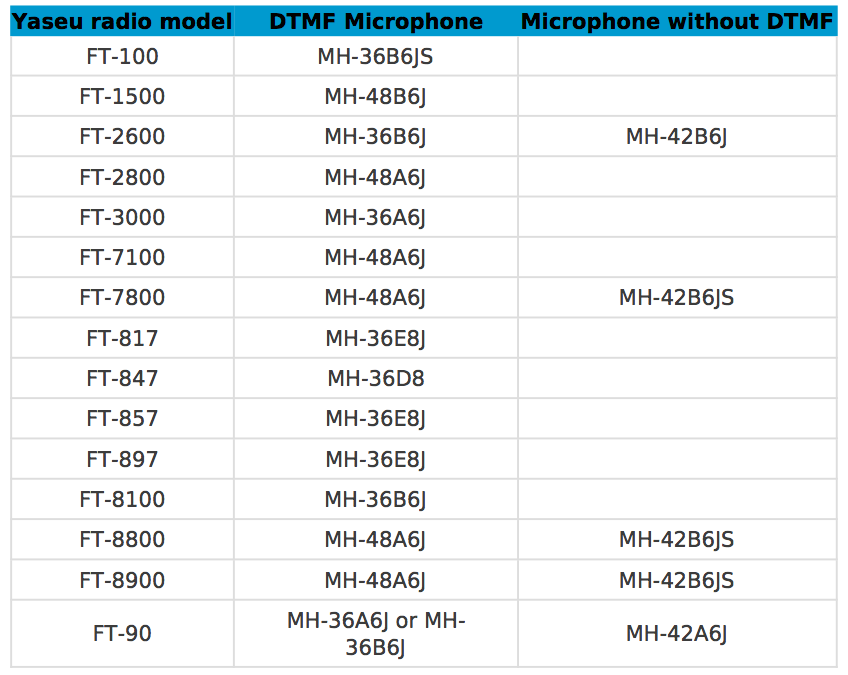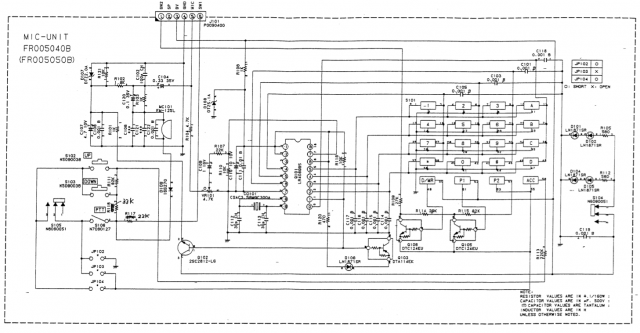After updating my FT100, see FT100 MLU, Murphy attacked. The PTT switch inside the mike started to act weird, just as I was on holiday and operating /A from Denmark. Of course, I didn’t expect a switch failure and thought it was RF getting into the transceiver. After some Internet research it became clear that this PTT switch failure is a common FT100 failure. One solution is to order a replacement switch from Yaesu, which apparently is still possible (at least in the US). Alternatively you can buy a new mike from Ebay for little money and upgrade to DTMF along the way (the FT100 was sold in Europe without DTMF mike). That’s where things get interesting.
The FT100 uses the MH-36B6JS mike, and only the FT100 uses this type. The type commonly found cheap on Ebay is MH-36B6J. Well that’s nearly the same, isn’t it. Googling revealed that the differences lie in some resistor values. I found the following diagram where the author has corrected resistors R116 and R117 to make it work for a FT-100.
Note that diode D109 makes the mike mute when PTT is not pressed. If you use VOX, remove this diode and connect the anode side to ground. So buy a MH-36B6J, modify it and off-you-go… Unfortunately this involves two very small SMD resistor replacements, an impossible job without the proper equipment.
I was lucky to find the correct type from an US Ebay seller. But beware, the alternatives, i.e. without the ‘S’ simply don’t work. I tried it myself and ended up sending the item back.
There’s one alternative left: buy the MH-36B6J and use it as an expensive PTT switch replacement part. But that’s stupid…


Hello and Thank You for your interesting (and practical) article. I, too own a Yaesu FT-100D (actually two) and very much like Shure hand microphones. I have spent hours trying to replace the MH-36B6JS with a Shure 527 mic. I thought that Yaesu used only 3 wires for both Mic+, PTT and Gnd (for both Mic- and PTT-). I must be mistaken. I can make and fit a 6-pin adapter plug into the face of the radio. The problem comes with knowing which pins to solder the new mic to. One diagram numbers the pins from 1 to 6 moving from left to right. Another diagram numbers them from 6 to 1 moving in the same direction. The user’s manual does not label them at all, or state the orientation of the (I presume) jack.
Since some hams on e-Bay market short adapter connectors that plug directly into the 6-pin jack and terminate with an 8-contact microphone connector, my guess is that my goal is possible if I know which of the 6 wires to use.
Any help would be greatly appreciated. Thank you in advance for your assistance and your time.
Randy Smith, KF5YMT/AAR6KQ
randynlr@yahoo.com
Hi Randy,
You can find a lot of FT100 info in “FT100 Undocumented.pdf” (Try Google search). It has a section on Mic Adapter and pin layout. Key item here is that the microphone PTT switch uses a 27k resistor in series to trigger the PTT. You’re right, only three wires are required, but without the resistor the PTT won’t work.
Frank
Frank,
Hi and thanks so much for your reply and helpful info. As soon as I finish this, I’ll visit the website (pdf) that you cited. My thinking is back in the CB days. This is how I thought Yaesu differed from Kenwood (3 vs. 4 connections for mic. and PTT). I have 3 of your Yaesu adapters, and they work perfectly. On this particular rig, in a particular vehicle, I wanted to wire the mic. directly. Part of my problem is that I did not insert a 27k resistor in series w/the PTT circuit, as you point out. Thanks again, and thanks for making quality (and useful) amateur radio products for which there is a true need.
Best regards,
Randy Smith
Frank,
Having recently picked up an FT-100, I was aware of the “Sundely MH36” without the S, and the fact that the PTT didn’t work. Helping another ham in town had previously pointed that out to me. We in fact turned it into an “expensive PTT switch replacement” because of time. This one that I picked up had the same issue, so I dove in, thinking that maybe he bought the wrong one. Of course I have the non s mic, no PTT working Sundely. So now off to Googling issues.. and I found you.
What I am wondering and want to confirm, looking at the schematic, the silkscreen and the documentation, I’m wondering if there is a typo. The resistors that are clearly changed for the project appear to be 117 and 116? You mention 118, but R118 is located on the other side of Q101 and is a 10K, and doesn’t indicate a handwritten change. Due to the tiny print, it appears as though maybe it should be R117 is a 22k, and R116 is the 33k? Just wanted to confirm before I tore open my $16 Sundely. :)
Thanks for the article!
Charlie
N5WE
Hey Frank,
Small update. I took a soldering iron, removed R117 (22k) and replaced it with a 27k with a good old fashioned through the hole resistor (thank goodness R117 is located where there’s enough room) and the PTT, Up, Down and ACC all work just fine! So if anyone happens to pick up one of these Sundely MH-36’s and are trying to use it on an FT-100D, just replace R117 with a 27K resistor and you’ll be good to go! No surface mounts needed either, plenty of room for a conventional resistor.
Thanks for the post!
Charlie
N5WE
Hi Charlie,
You’re right. In the post text I mention R117 and R118, but this should be R116 and R117. This is now corrected and thanks for pointing this out! I’m glad the modification worked for you.
73 Frank
Can you post a picture? My mic shows no silk screened component numbers on the board and I have no idea where R117 is.
Thanks!
Best 73
Jeff – W5JGW
Hi Frank,
thank you very much for all the helpful information on microphones for YAESU FT-100.
I will try to get a Sundely MH-36 and modify resistors accordingly.
Did your FT-100 ever encaounter problems with VHF7UHF finals?
73 de Mike, oe3mzc
Hi Mike,
Regarding the finals, I did not have any problems. But I have the Fan mod done and have never used the FT100 on FM full power QSOs. You cannot expect the FT100 having the same duty cycle as a TS2000.
73 and GL with the Sundely MH-36.
Frank
FT100 mike problem solved
Goodmorning all. The cable from my FT100 mike was shot, the plastic was breaking up. I took a mike-cord of a Motorola-mobile radio MC900/MC2100, those are RJ11 and 6-wires too. Soldered it to the connector that was inside the mike, problem solved.Colours didn’t match but that was no problem hi. It works fine, the rest of the mike was good !
Hallo Jan, thanks for the tip!
In January 2018 my MH-36B6JS PTT started to act weird and I found this web site. First I tried to use contact cleaner, but that did not work. Next, I ordered a Sundely MH36 ($20 on eBay) and replaced the resistor. I removed the surface mount 22K and added a 27K 1/8-watt resistor between the hot side of the existing pad and the PTT switch. All worked well. The panic was over. I then called Yaesu to see if they had any N7090127 switches and they gave me that “replacement” part number S8102323 that others say will not fit. I did some searching and found one that looked like it would fit from Newark.com. It fits and works well. The switch was less than a dollar and two-day shipping & handling was $5.95. The existing screw holds the new switch in place. I thought I was going to have to use some glue as there is no “nub” for the other hole, but none was needed. Thanks for everyone’s input.
Manufacturer: HONEYWELL
Manufacturer Part No: ZX40E30C01
Newark Part No.: 86C1714
Ken
K6UF
I’m glad I found this webpage as I stumbled across the same problem. The only thing I can add is that the initial comments seem to be backward. The “S” version of the MIC has R117 = 27K and R116 = 39K. The non-S version I bought from China measured 22K and 36K respectively. So the author than modified the schematic changed it from the “S” version schematic to the Sudenly-version of the schematic. This is confirmed by Mr. Morrison’s comment that changing the Sudenly-version 22K resistor back to 27K makes the microphone work.